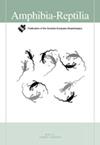揭示南美洲开放栖息地矮沼泽蛙Pseudopaludicola mystacalis(无尾目,细齿目)的神秘多样性和进化
IF 1.3
4区 生物学
Q3 ZOOLOGY
引用次数: 1
摘要
许多关于南美洲生物群多样性的研究支持生态和地质事件作为物种多样化的主要驱动因素的作用。对许多群体来说,地貌事件是多样化的关键驱动因素,而更新世气候振荡的影响对其他群体来说尤为突出。为了准确地表明哪些事件是南美洲惊人的生物多样性发展的关键,对广泛分布的物种的研究至关重要。其中一个物种,矮沼泽蛙Pseudoodactylidae,Leiuperinae,广泛分布在南美洲的开放栖息地,我们在这里调查了该物种在其地理范围内的种群分化和多样化。我们对来自25个地方的64个标本的1374bp mtDNA片段进行了测序。我们使用种群分配和物种划界方法来评估整个物种分布的遗传结构和谱系限制。我们估计了每个谱系的种内多样性、分化时间和人口统计学历史。我们的研究结果发现了10个谱系,它们之间的遗传差异高达5%。多样性主要发生在第三纪,表明中新世-上新世地形事件对mystacalis的多样性有重大影响。更新世的气候振荡也对mystacalis的进化史起到了一定作用,导致了一个谱系的人口结构变化。本文章由计算机程序翻译,如有差异,请以英文原文为准。
Unravelling the cryptic diversity and evolution of the dwarf swamp frog Pseudopaludicola mystacalis (Anura, Leptodactylidae) in open habitats of South America
Many studies on the diversity of the South American biota support the role of ecological and geological events as main drivers of species diversification. For many groups, geomorphological events are the key drivers of diversification, while the influence of Pleistocene climate oscillations is prominent for others. To precisely indicate which events were key for the development of the astonishing biodiversity in South America, studies on widely distributed species are paramount. One such species, the dwarf swamp frog Pseudopaludicola mystacalis (Leptodactylidae, Leiuperinae), is widely distributed in open habitats of South America and we herein investigate population differentiation and diversification in this species across its geographic range. We sequenced a 1374 bp mtDNA fragment from 64 specimens across 25 localities. We used population assignment and species delimitation methods to assess genetic structure and lineage limits across the species distribution. We estimated, for each lineage, intraspecific diversity, divergence times, and demographic histories. Our results recovered ten lineages with up to 5% of genetic divergence among them. Diversification occurred mainly during the Tertiary, suggesting that Miocene-Pliocene topographic events had a major influence on the diversification of P. mystacalis. Pleistocene climatic oscillations also played a role on evolutionary history of P. mystacalis, causing demographic changes in one lineage.
求助全文
通过发布文献求助,成功后即可免费获取论文全文。
去求助
来源期刊

Amphibia-Reptilia
生物-动物学
CiteScore
3.10
自引率
6.20%
发文量
39
审稿时长
6-12 weeks
期刊介绍:
Amphibia-Reptilia is a leading European multi-disciplinary journal devoted to most of the aspects of herpetology: ecology, behaviour, evolution, conservation, physiology, morphology, paleontology, genetics, and systematics.
Amphibia-Reptilia publishes high quality original papers, short-notes, reviews, book reviews and news of the Societas Europaea Herpetologica (SEH). The Societas Europaea Herpteologica (SEH) website is located at: www.seh-herpetology.org.
 求助内容:
求助内容: 应助结果提醒方式:
应助结果提醒方式:


